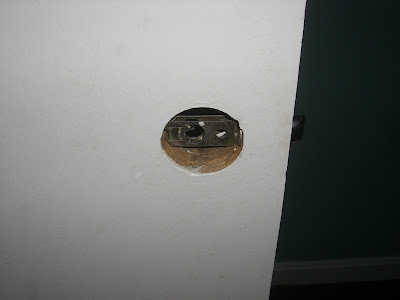Exhibit C: One of the older doorknobs and hardware still left on the house. Possibly a wood or mineral doorknob.

I've begun working more on the upstairs part of the house. As a result, I've been noticing more about the upstairs. Like the doors that absolutely do not fit in their frames (adds character).
And then there is the missing doorknobs. If I'm not careful, I can get stuck in one of the bedrooms. Two of the upstairs doors are missing their doorknobs (Exhibit A & B). I have a feeling that the doorknob on Exhibit A would have been older and, I like to think, pretty. I think a previous tenant stole it.
Or maybe it just pulled out one day and they never bothered replacing it? Nah, they stole it. Filthy, rotten doorknob thieves!
But all of my huffing over missing doorknobs made me curious about antique door knobs. After all, I really like the mineral/wood knob in Exhibit C.
I did a little research and came across a helpful site on antique doorknob identification. Basically:
The first doorknobs started appearing in colonial days, were made of wood, and were practical. Most doorknobs in the U.S. were imported up until 1876.
You can tell the approximate age of an antique doorknob by the shape, design, and material:
- Pressed glass was popular from the 1820s to the 1850s.
- Cut glass was popular from 1860s through 1910.
- Wooden knobs were used from about 1885 though 1910.
- China knobs were imported from England and France through the 1850s.
- Cast metal became available in the mid 1840s.
- In 1870, a method for compression casting allowed the Victorians to have the more detailed hardware that they craved.
Most brass doorknobs create prior to WWII were donated to the war effort and melted down. That makes them rare, so if you have a pre-WWII brass doorknob, it's probably worth a lot.
Upon further exploration, I even found a virtual doorknob museum! This Nashua Lock Company doorknob looks a lot like my doorknob (Exhibit C). I know, I'm the only one excited by the virtual museum. But it's really cool to see all the different styles of door knobs and locks.
I'll take a closer look at all the doorknobs in the house to make sure I didn't miss anything neat!



I like doorknobs! My mom has a cut glass one that she bought at a thrift store in college. She carted around with her to each of the houses she lived in and finally only put it on a door a few years ago.
ReplyDeleteIn addition to doors with character, I like doorknobs with character
... unless it's the peeling fake brass-ness that defines most of our doorknobs... ;)